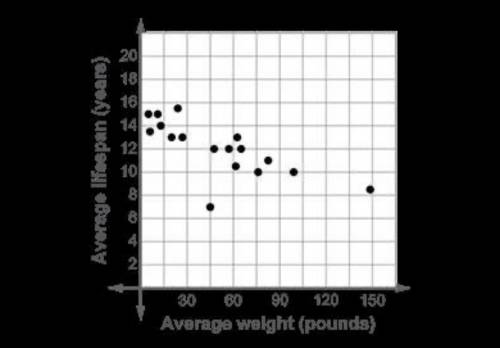
Mathematics, 31.03.2021 22:00 anher
Dr. Wong has a table of data in her veterinary office that shows the average lifespans and weights of several popular dog breeds. Alfonso made a scatterplot of these data for a math project.
Answer the questions to make predictions about the lifespan of a specific breed of dog.
1. Describe the association shown by this scatterplot.
2. Alfonso is thinking of getting a bloodhound. Bloodhounds usually weigh about 90 pounds. Based on the data, estimate for the lifespan of a bloodhound. Explain how you made your estimate.
3. Alfonso's friend Dani tells Alfonso that her bloodhound, Ol' Sniffy, lived to be 14.
Based on what you know, do you think this was because:
1. Alfonso didn't use a good estimation method,
2. Dani doesn't remember Ol' Sniffy's age correctly, or,
3. Ol' Sniffy lived an unusually long time?
Justify your answer.


Answers: 3


Other questions on the subject: Mathematics

Mathematics, 21.06.2019 16:30, angeline310
Refer to the table below if needed. second quadrant third quadrant fourth quadrant sin(1800- - cos(180° -) tan(180°-e) =- tane cot(1800-0) 10 it to solo 888 sin(180° +c) = - sine cos(180° +) =- cose tan(180° +c) = tane cot(180° +o) = cote sec(180° + c) = - seco csc(180° +2) = - csce sin(360° -) =- sine cos(360° -) = cose tan(360° - e) =- tane cot(360° -) = -cote sec(360° -) = seco csc(360° -) = csco sec(180° -) = csc(180° -) = csca 1991 given that sine = 3/5 and lies in quadrant ii, find the following value. tane
Answers: 2

Mathematics, 21.06.2019 17:00, SillyEve
In tossing one coin 10 times, what are your chances for tossing a head? a tail? 2. in tossing one coin 100 times, what are your chances for tossing a head? a tail? 3. in tossing one coin 200 times, what are your chances for tossing a head? a tail? deviation = ((absolute value of the difference between expected heads and observed heads) + (absolute value of the difference between expected tails and observed tails)) divided by total number of tosses. this value should always be positive. 4. what is the deviation for 10 tosses? 5. what is the deviation for the 100 tosses? 6. what is the deviation for 200 tosses? 7. how does increasing the total number of coin tosses from 10 to 100 affect the deviation? 8. how does increasing the total number of tosses from 100 to 200 affect the deviation? 9. what two important probability principles were established in this exercise? 10. the percent of occurrence is the obtained results divided by the total tosses and multiplied by 100%. toss the coins 100 times and record your results. calculate the percent occurrence for each combination. percent head-head occurrence: percent tail-tail occurrence: percent head-tail occurrence:
Answers: 3

Mathematics, 21.06.2019 20:30, AdanNava699
If you are dealt 4 cards from a shuffled deck of 52? cards, find the probability that all 4 cards are diamondsdiamonds.
Answers: 1
You know the right answer?
Dr. Wong has a table of data in her veterinary office that shows the average lifespans and weights o...
Questions in other subjects:



Arts, 27.11.2020 08:40

Mathematics, 27.11.2020 08:40

English, 27.11.2020 08:40

English, 27.11.2020 08:40

English, 27.11.2020 08:40

Social Studies, 27.11.2020 08:40

Spanish, 27.11.2020 08:40

Mathematics, 27.11.2020 08:40



